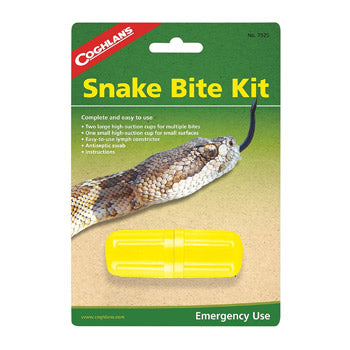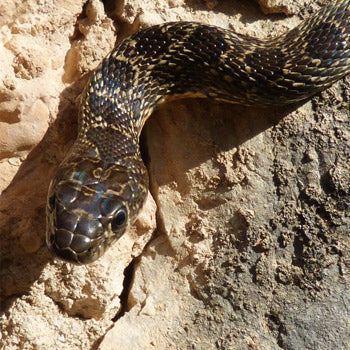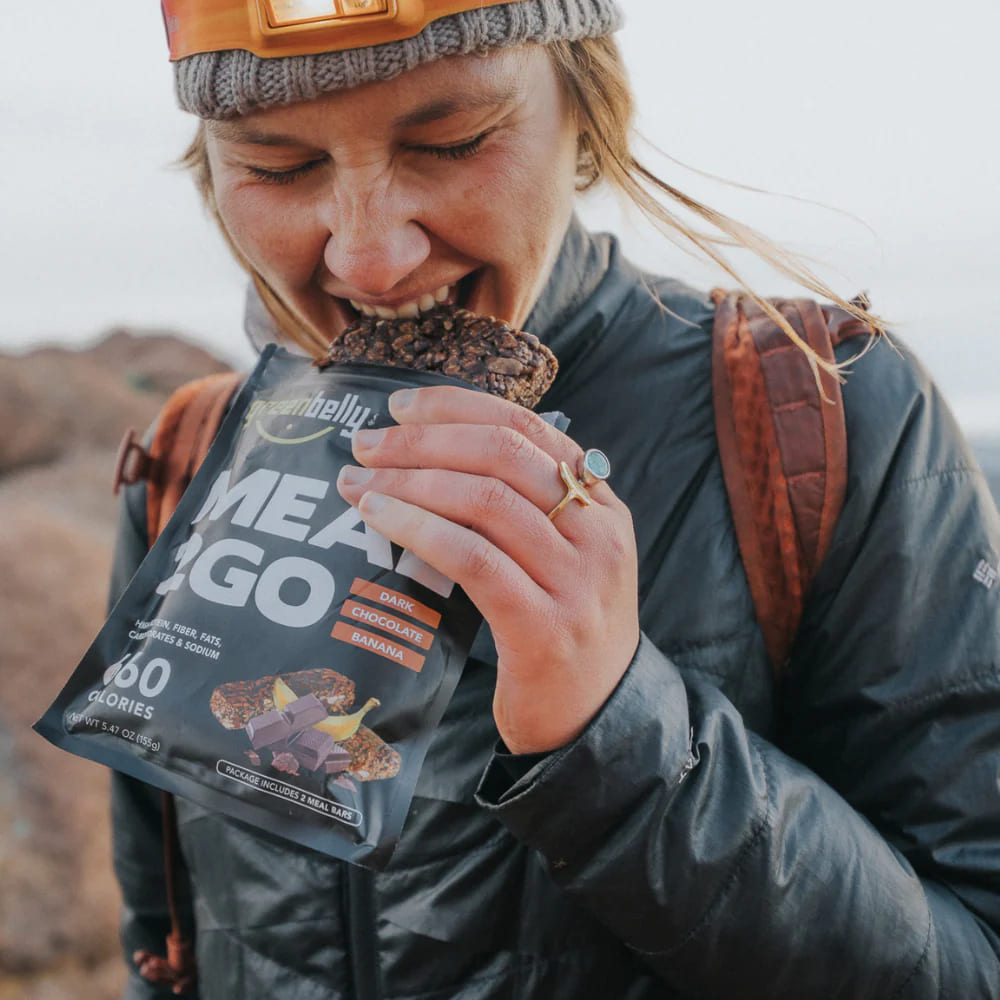Snakes are common worldwide, especially in the warmer climates where they thrive. Though encountering a snake on the trail can be unsettling, most confrontations end peacefully with the human and snake going on their own way. Occasionally, the encounter is a surprise one, and the snake bites to protect itself. Some hikers choose to carry a snake bite kit, especially if they are traveling in an area known for its snake population. These portable kits contain first aid supplies and sometimes a suction device to treat a snake bite.
There are two basic types of snakebite kits: a commercial kit (like this one from Sawyer) and a DIY kit with necessary first aid supplies. The retail kit contains a plunger-style suction device that pulls the venom out of a wound. It also may have a razor to remove hair, basic wound cleaning materials like alcohol pads, and bandages to cover the snake bite. A DIY kit is one that you assemble yourself and contains basic first aid supplies you need to clean and dress a snake bite.
Are Snake Bite Kits Effective?
ARGUMENTS AGAINST: Snakebite kits are controversial. Many first aid and wilderness medicine groups, like the Red Cross and NOLS, do not recommend the use of the suction devices found in snake bite kits. These groups point to a handful of studies that show the amount of venom removed from a wound is insignificant. There also is a chance that the suction from the device will damage the tissue surrounding the bite area (PubMed study). Lastly, there is a concern that people who use a snake bite kit will not seek further treatment because they believe they have been cured.
ARGUMENTS FOR: We reached out to manufacturers and those on the other side of the controversy who claim that the studies against suction devices are flawed. In fact, some of the above-mentioned studies tested the venom extraction five minutes or more after the simulated bite, which is outside the timeframe recommended by manufacturers. The longer you wait to extract the venom, the greater the chance it has reached the circulatory system and is no longer at the site of the wound. If the venom is no longer at the wound, then a venom extractor is ineffective.
The "pro-extractor group" also pointed out that some studies injected the mock venom into the leg of the study participants. Snake bite kits are not recommended for use on the leg because the legs are muscular and have an ample blood supply that absorbs venom like a sponge.
BOTTOM LINE: All in all, although snakebite kits are controversial, many hikers still choose to carry one just in case, but also because they help relieve bee stings, mosquito bites, and remove abscesses as well as botfly larvae.

Suction pumps are also advertised to work against various insect bites and stings.
How Are They DESIGNED to Work?
To get the most out of your kit, there are some guidelines and limitations you should follow.
A. THE KIT IS USED WITHIN 3 MINUTES OF THE BITE
Snake bite kits are most useful when they are applied as soon as possible after a bite to remove venom at the surface of a bite. The longer you wait, the more likely the poison will reach the bloodstream and will no longer be extractable using suction.
B. THE BITE OCCURRED ON A NON-MUSCULAR AREA
It also helps if the bite is in an area that is not muscular, such as the hand, foot, or ankle. In these areas, the venom pools at the surface and is more accessible. A muscular area like the calf has an ample blood supply that acts like a sponge and quickly carries the venom deeper into the body.
How to Use a Snake Bite Kit?
Here are step by step instructions on how to use a snakebite kit starting from the moment of the bite to when you reach a medical facility.
Before Using the Extractor:
✔️ After a bite, remove the injured person from the vicinity of the snake to avoid incurring a second bite*.
✔️ Keep the victim calm as an increase in the heart rate will circulate the venom throughout the body more rapidly.
✔️ Keep the limb with the bite immobilized and below heart level to minimize the spread of the venom.
You're now ready to use your snake bite kit. Here's how to do it:
- Pull out the extractor. Minutes count as the extractor is most effective in the first few minutes following a bite.
- Find the suction cup that best fits the size of the wound.
- Attach the cup to the end of the plunger and pull the plunger all the way out.
- Place the suction cup gently on one of the fang holes and push the plunger all the way down until a strong suction is felt and skin with the bite is pulled up into the suction cup.
- Apply suction for two to three minutes on the fang hole and then switch to the next fang hole.
- Pull up on the plunger to remove the suction and wipe away any bodily fluids or venom that leaked from the wound.
- Alternate between fang holes every two to three minutes for a maximum of 15 minutes. Stop using the plunger after 15 minutes to minimize damage to the surrounding tissue.
- Wash the wound with water and soap if available, wipe with an alcohol pad, and cover lightly with a bandage.
Whether you used the extractor or not, it is imperative that you get the injured person to the hospital as soon as possible for further treatment. Call 911 if necessary. After treatment, clean the suction cup and sterilize it. Do not wash the plunger as that may ruin the seal that helps provide the suction.
*: Do not worry about identifying the type of snake, unless it is a coral snake. The antivenin treatment is the same for all poisonous snakes, except the coral snake. Coral snake venom is a neurotoxin and requires a different treatment.

1. Position suction cup over one fang | 2. Push the plunger in to initiate the suction
Bit by a Snake? Here's What NOT to Do
When dealing with a snake bite, there are several things you should not do because they could increase the spread of the venom or cause additional trauma to the wound.
❌ Do not apply a tourniquet: The venom from some snakes has a tissue destroying compound. Constricting this chemical to the bite area using a tourniquet could cause extensive tissue damage. It also may cut off the blood supply to the affected area which could lead to gangrene and possibly amputation. It's better to let the venom spread, but slow its spread by keeping the patient calm.
❌ Do not cut the wound with a knife and suck out the venom: This method has not been shown to remove the venom and increases the size of the wound.
❌ Do not apply ice or immerse the wound in cold water: Cold water or ice can reduce the blood flow to the area, which could make the injury worse by keeping the venom restricted to the bite area.
❌ Do not drink alcohol as a painkiller: Do not use alcohol as a painkiller as the victim needs to be alert and clear thinking during treatment.
❌ Do not drink caffeinated beverages: Caffeinated beverages can increase the heart rate, which will move the venom more rapidly through a person's system. You want to slow the spread of the poison as much as possible without constricting it.
Where Can I Buy a Snake Bite Kit?
Snakebite kits can be found at outdoors stores like Cabela's and REI, as well as retailers like Walmart. You also can buy them online. There are several different kits from which to choose, but all of them use the suction method as their primary form of treatment. Some also include constriction to slow the spread of the venom which is currently not recommended.
Sawyer Extractor Pump Kit

Method: Suction
Price: $17 (available at Amazon)
Contents:
- Sawyer Extractor pump
- 4 suction tips
- Alcohol prep pads
- Adhesive bandages
- Sting care wipes
- Razor (for hair removal)
- Instruction manual
The Sawyer Extractor pump kit is the gold standard for bite and sting kits. The package contains a powerful extractor pump and four different tips to fit the type of bite or sting you are treating. It's this pump that sets the Sawyer kit apart. It’s easy to use and has a powerful suction There's also a razor blade to remove hair around the bite or sting and first aid supplies to treat stings as well as snake bites. .
Coghlan's Snake Bite Kit

Method: Suction and constriction
Price: $6 (available at Walmart)
Contents:
- Pliable suction cups
- Scalpel
- Antiseptic swab
- Lymph constrictor
Coghlan's snake bite kit is a portable and lightweight kit with both a suction device and a constrictor band. The suction cup can pull out the venom, while the band is designed to slow the blood flow and not cut it off entirely. Though there is an antiseptic swab to clean the wound, there is no bandage. You have supply your own dressings or band-aids.
Ven-Ex Snake Bite Kit

Method: Suction and constriction
Price: $15 (available at Amazon)
Contents:
- Hard-shelled carry case.
- Sturdy and reusable extraction pump
- 2 extraction cups
- A tourniquet band
- CPR Face Shield in 2"x2" nylon webbing pouch.
The Ven-Ex Snake Bite Kit is one of the largest kits on our list with a constrictor band, a suction device, a CPR face shield, and two different-sized plastic extraction cups for effective suction on a wide variety of bites or stings. It includes a hard shell case for storage and a nylon pouch for the CPR shield. Similar to the Coghlan's kit, the Ven-Ex snake bite kit does not include band-aids or wound dressings.
How to Make Your Own Snake Bite Kit
You can easily make your own snake bite kit using the following first aid supplies:
- 4x adhesive sheer plastic or fabric bandages to cover snake bite wound
- 4x antiseptic Towelettes or Alcohol Prep pads for wound cleaning
- 4x 3x3-inch or 2x2-inch gauze pads to clean and cover the wound
- 1x sharpie to mark the wound area
- 2x ammonia Inhalants in case the bite victim loses consciousness
Common Poisonous Snakes in the USA
There are only a handful of venomous snakes in the US, and most of these snakes are concentrated in the southeastern and southwestern United States. Hotbeds for snake activity include Texas and Florida, which account for one in four reported snake bites nationwide, as well as Georgia, North Carolina, Arizona, and California.
Most of the venomous snakes in the United States are pit vipers, which have a heat-seeking pit between their eyes and nostrils to help find prey. The pit vipers have a hemotoxic venom that breaks down tissue, destroys red blood cells and prevents blood from clotting. Not all venomous snakes in the US are pit vipers, the one exception is the coral snake, which is closely related to the cobra. The coral snake has a neurotoxin that affects the nervous system and can be fatal.
Coral Snake

A cousin to the cobra, the coral snake is one of the most venomous snakes in the world. It is a small snake, growing only up to two-feet long. You can't miss a coral snake when it is out in the open. The snake is brightly colored with bands of black, red, and yellow. There are several nonvenomous snakes, like the scarlet king, that have a similar banding pattern. Remember this familiar rhyme to help you recognize the coral snake: "red next to yellow kills a fellow, red next to black is safe for Jack.”
The eastern coral snake is found primarily in the southeastern United States from North Carolina to Florida, Louisiana and southeast Texas, while the western coral snake is found from Arizona to New Mexico. Coral snakes live in woody, sandy or marshy areas. It often is found hiding under leaves or grasses and can burrow underground. It is most active in the early morning and evening.
The coral snake is timid and does not bite unless provoked. Though people get bitten each year, most bites are the result of people handling the snake, believing it is the nonvenomous scarlet king snake. It has small fangs and chews on its prey instead of inflicting a bite. As a result, the coral snake usually only injects a small amount of venom into its victim. The poison is a potent neurotoxin that causes respiratory distress, so any bite should be treated immediately.
Rattlesnake

Rattlesnakes are among the most widespread of the venomous snakes with a range that extends from southern Canada to South America. There are an estimated 30 different species of rattlesnake in the US. Rattlesnakes are most abundant in the deserts of the southwestern United States, but that's not their only habitat. Depending on the species, they can be found on rocky mountainsides, dense forests, and even swamps. Rattlesnakes are known for the rattle at the end of their tail that serves as a warning to passersby.
Rattlesnakes are most active during the spring, summer and fall months and prefer temperatures between 80-90F. During the hottest part of the day, rattlesnakes will seek a shady place to escape the high temperatures and blazing sun.
Rattlesnakes tend to be more aggressive than other venomous snakes and can bite with minimal provocation. The venom is hemotoxic, destroying the tissue around the bite, lysing red blood cells and preventing the bite victim’s blood from clotting. The rattlesnake has large fangs and injects a high dose of venom in a single bite. This large bite load and potent venom make the rattlesnake one of the most dangerous venomous snakes in the US.
Copperhead

The copperhead is one of the most common venomous snakes in the eastern United States, with a range that extends from northern Georgia to Massachusetts and west to Illinois. Copperheads are found in a wide variety of habitats including rocky hillsides, dense forests and swampy areas. They can handle habitat change and often are found in the suburban areas of cities. Copperheads are known for their heavy body with an hourglass pattern and copper-coloring that matches leaf litter. It is most active from spring to fall and enjoys basking in the warm sun during the day.
The copperhead is responsible for the majority of venomous snake bites in the United States, but the bite is rarely fatal. The copperhead's venom is not very potent, so its bite is not as dangerous as other venomous snakes. The copperhead is not an aggressive snake; it tends to freeze and usually only strikes when physical contact is made. Most bites occur because someone has picked it up or stepped on it accidentally.
Cottonmouth

The cottonmouth, also known as the water moccasin, gets its name from the light-colored interior of its mouth. The snake has a triangular-shaped head with wide jowls and a heavy body. It is a semi-aquatic snake that lives near freshwater sources, especially swamps and vegetated wetlands. It typically basks in the sun on logs and rocks during the day and forages for food at night. It eats fish and amphibians, along with rodents and birds. It is common in the southeast US, with a range from Florida to southeastern Virginia.
The cottonmouth opens its mouth as a warning sign, making it easy to identify. The snake tends to stand its ground when confronted and will follow you as you walk around it. Thankfully, a cottonmouth won't strike as quickly as a rattlesnake and usually only bites when handled or stepped on. It is a pit viper and has a hemotoxic venom with enzymes that may cause gangrene around the site of a bite.






 650-Calorie Fuel
650-Calorie Fuel